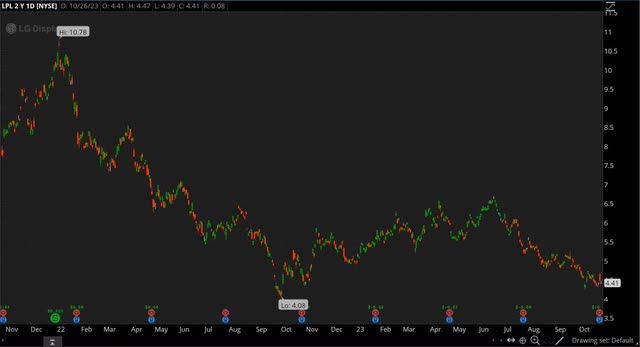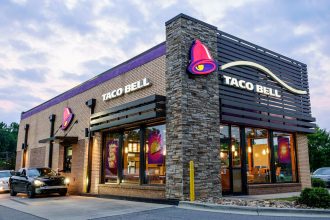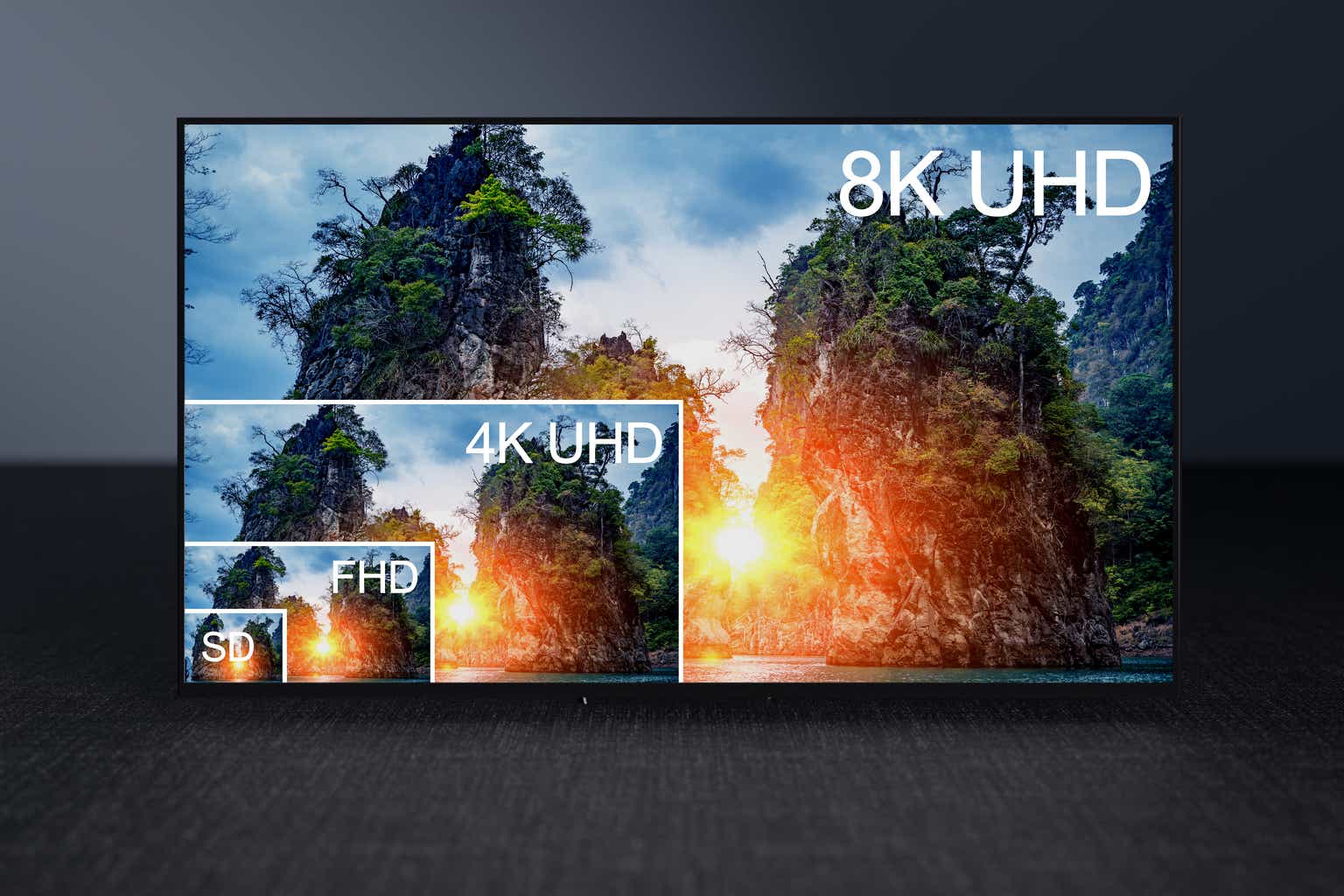LG Display (NYSE:LPL) released its latest earnings report on October 25 and the results for Q3 showed an improvement as anticipated, but LPL also fell short of guidance as the improvement was significantly less than expected. However, the stock handled the disappointment relatively well with not much change because LPL was able to offset the disappointing results with the prospect of a return to profitability, perhaps as soon as Q4. Still, questions remain. Why will be covered next.
LPL posts another quarterly loss, but probably not for much longer
A previous article from July rated LPL a hold even though the company was likely to show improved quarterly results for several reasons, including what could be structural changes underway in the market for display panels, whether LCD or OLED. The display market continues to suffer from an imbalance between supply and demand, which has made earning a profit challenging for industry players, LPL included.
LPL thus headed into the earnings release with a streak of five consecutive quarterly losses and the streak was extended to six after another loss in Q3. Still, the Q3 numbers improved sequentially as anticipated, mostly due to seasonality kicking in at this time of the year. On the other hand, the numbers fell short of expectations. The table below shows the numbers for Q3 2023.
Consensus estimates, for instance, called for LPL to post an operating loss of KRW570B in Q3, but LPL reported a loss of KRW662B, which converts to about $0.49B using a USD:KRW exchange rate of 1:1,358. Q3 revenue declined 29% YoY, but it also increased by 1% QoQ to KRW4,785B or $3.52B. LPL ended with a net loss of KRW775B or $0.57B. EBITDA was KRW382B or $0.28B, almost as much as a year ago with much less revenue.
|
(Unit: B KRW, except EPS) |
|||||
|
(IFRS) |
Q3 2023 |
Q2 2023 |
Q3 2022 |
QoQ |
YoY |
|
Revenue |
4,785 |
4,739 |
6,771 |
1% |
(29%) |
|
Gross margin |
0.8% |
(3.7%) |
0.7% |
– |
– |
|
Operating margin |
(13.8%) |
(18.6%) |
(11.2%) |
– |
– |
|
Operating income (loss) |
(662) |
(881) |
(759) |
– |
– |
|
EBITDA |
382 |
130 |
391 |
195% |
(2%) |
|
Net income (loss) |
(775) |
(699) |
(774) |
– |
– |
|
EPS |
(2,167) |
(1,953) |
(2,163) |
– |
– |
Source: LG Display
The loss on the income statement affected the state of the balance sheet. Cash and cash equivalents increased to KRW4,087B or $3B in Q3 2023, up from KRW3,853B in Q2 2023 and KRW3,264B in Q3 2022. On the other hand, LPL did turn to banks and others for financing and total debt increased to KRW17,487B or $12.87B in Q3 2023, up from KRW17,421B in Q2 2023 and KRW15,291B in Q3 2022. Net debt-to-equity ratio reached 151% in Q3 2023, up from 143% in Q2 2023 and 84% in Q3 2022.
The Q3 results fell short of expectations for a reason. Q3 guidance had called for display area shipments to increase in the mid single digits and for average selling prices to increase in the high single digits QoQ, but actual shipments increased by just 1% QoQ to 4.8M square meters and ASP was flat at $804 per square meter, both well short of expectations. LPL attributed this to production problems, which caused delays in shipments.
|
Shipments (M m²) |
QoQ |
ASP/m² |
QoQ |
|
|
Q3 2023 |
4.8 |
1% |
$804 |
– |
|
Q2 2023 |
4.7 |
11% |
$803 |
(6%) |
|
Q1 2023 |
4.2 |
(46%) |
$850 |
20% |
|
Q4 2022 |
7.9 |
2% |
$708 |
5% |
|
Q3 2022 |
7.7 |
(2%) |
$675 |
19% |
|
Q2 2022 |
7.8 |
(4%) |
$566 |
(14%) |
|
Q1 2022 |
8.1 |
(13%) |
$660 |
(18%) |
However, LPL expects to make up for the delays in Q4, thanks in large part to the upcoming holiday season. Q4 guidance calls for area shipments to increase by 19% QoQ and ASP are expected to increase by mid-20% QoQ. This is likely to pull LPL out of the red, something LPL had said it was aiming for. From the Q3 earnings call:
“Next, on Q4 guidance. With increase in TV panel shipment to respond to year-end demand as well as expansion in the previously delayed IT panel shipment, shipment area in Q4 is expected to grow by 19% Q-o-Q. Shipment of panels for smartphones with high ASP per square meter is expected to grow, likely to drive up ASP per square meter by mid-20% level Q-o-Q.”
A transcript of the Q3 2023 earnings call can be found here.
Why some may consider going long LPL
Guidance was able to offset the worse-than-expected quarterly results and the stock took the latest report in strides. Still, LPL has lost 11% YTD with the stock in the midst of a slide that has lasted months as shown in the chart below. Note how the stock did much better in the early part of 2023 compared to recent months.
Source: Thinkorswim app
The stock gained from January to June, eventually reaching a 2023 and 52-weeks high of $6.69 on June 20, but its been downhill since then. This may not have been a coincidence. Keep in mind the uptrend from earlier in the year started last year and it was preceded by a downtrend. A 38.2% Fibonacci retracement of the downtrend, starting with the January 2022 high of $10.78 and ending with the September 2022 low of $4.08, is $6.64, which is just $0.05 below the aforementioned $6.69. It appears the stock hit a resistance level.
The stock is now at $4.41 as of October 26 after getting as low as $4.25 on October 6, which is close to the September 2022 low of $4.08. The stock proceeded to rally after the September 2022 low and if LPL repeats what happened back then, the stock may be in the starting block of another rally.
It’s possible the stock may still try to revisit the September 2022 low, but it is more likely the stock will turn higher at this point. Remember that the only other time the stock managed to get any lower than $4.08 was during the post-COVID19 stock market selloff in March/April 2020. In other words, the stock is near the lows of the last decade, which makes a move higher more likely than a move lower.
Why LPL can be said to be below fair value
There is another argument in favor of long LPL. LPL is in the red and has been for some time, which makes putting a fair value on LPL somewhat tricky. Still, while fair value is admittedly highly subjective, a case can be made that LPL is trading below fair value. For instance, as of Q3 2023, LPL had total assets of KRW37,538B and total liabilities of KRW28,648B, which means LPL has a book value of KRW8,890B or about $6.55B depending on the exchange rate.
The stock is priced at $4.41 per ADR, which translates to a market cap of $3.16B with the number of shares outstanding at around 715.6M. Such a market cap of $3.16B is quite low for a company with TTM sales of KRW21,237B or $15.6B. The stock price or market cap is also way below book value with price-to-book at around 0.48.
Granted, this is for a company operating at a loss, which will eat away at book value if losses continue. Nonetheless, an argument can be made that fair value for LPL would be roughly double the current stock price or about $9. This is because if LPL were to liquidate, the company would be valued at book value. A stock at multi-year lows, which also happens to be trading at less than 0.5 times book value may be enough to convince some of the merits of long LPL.
Why there are still question marks hanging over LPL
If guidance is any indication, the streak of quarterly losses is set to end at six as LPL is likely to return to profitability in Q4. However, while LPL may earn a profit in Q4, especially with the help of a solid holiday shopping season, there are reasons to doubt whether LPL will be able to stay out of the red on a sustained basis.
As mentioned in the prior article, the display market is in a state of flux at the moment with many changes underway in different areas, including on a technological level and in terms of the competitive landscape. In response, LPL has reacted to a difficult market with a number of initiatives. For instance, LPL has sought to cultivate new market segments like automotive where display panels are not yet so common and where the market could still expand for that reason alone.
However, the competition has also sought to do the same and it appears some are having more success than LPL. For instance, according to a recent report, competitors from China have tripled their share of the automotive market from 15.3% in 2017 to 46% in 2022. On the other hand, LPL is in a better position if only OLED is included. LPL is estimated to hold roughly half of the automotive OLED market, which is why automotive accounts for about 10% of total revenue. Still, LPL has its work cut out because the competition is clearly looking to gain market share.
Furthermore, while OLED has a technological edge in certain aspects versus LCD, this edge is under threat. MiniLED, for instance, promises to narrow the gap with one of OLED’s chief advantages, which is superior picture quality. Several OEMs have released their latest miniLED TVs in time for the shopping season and it appears OLED is in for a tough fight.
While picture quality is subjective, early reviews suggest little to no difference between OLED and miniLED, including in terms of contrast. These miniLED TVs are able to accomplish this without sacrificing existing advantages of LCD versus OLED. On the contrary, they build on it. For instance, OLED lags in terms of brightness behind LCD, but OLED risks falling even further behind with high-end miniLED sets increasing brightness levels to as high as 5,000 nits or five times the 700-1,000 nits for the typical OLED TV.
All this with a price tag that is much lower than their OLED equivalent. It appears miniLED may be an even more competitive product than expected, which spells bad news for OLED, especially if the latter can no longer count on having an edge in picture quality. LPL stands to lose in such a scenario where OLED TVs do not come to dominate the market for higher-end TVs as many perhaps thought at one point in time.
Investor takeaways
I am neutral on LPL. LPL is very likely to return to profit in the Q4 report and it may even have a blowout quarter, but the question of what happens next remains unresolved. LPL faces a ton of challenging issues, including a huge debt load, supply/demand imbalance and so on. It’s very possible LPL’s return to profitability won’t last more than one quarter. OLED was long believed to have a secure position in terms of superior picture quality, but that edge may be fading faster than expected if the latest products based on miniLED displays are any indication.
LPL has bet on OLED, but it remains to be seen if that bet was the right one. Furthermore, while the display market is getting the seasonal boost at this time of the year, the market has yet to find an answer for all the issues that are causing problems, including the oversupply of display panels that occur from time to time, which depresses prices and makes it hard to turn a profit.
Keep in mind that LPL needs sustained profits if it is to make a dent in its debt load, which currently stands at almost $10B after subtracting cash. LPL has worked out various strategies in order to cope with the difficulties in the display market, but it is not clear how effective they will be. Already, LPL’s big bet on the OLED market is facing a challenge from miniLED and other more advanced forms of LCD in the future. OLED TV was supposed to be LPL’s trumpcard, but if that is not it, then LPL needs to find something else and it is not clear what else is out there.
Bottom line, the long-term picture for LPL should give people pause with all the unresolved issues around, whether it is debt, the dearth of profits, the future of OLED, stiff competition and much more. The stock is probably due for a turnaround after sliding for the last four months. Seasonality is currently in LPL’s favor and the stock may do better in the next couple of months than it has recently. However, if long LPL is to truly turn into a sound investment, a whole lot of issues need to be resolved beforehand. That has yet to happen.
Read the full article here





